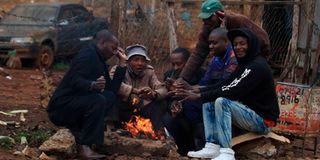Weatherman: Brace yourself for colder July

Mechanics warm themselves following cold weather at Grogan area in Nyeri town on June 26, 2018.
Kenyans have been asked to brace themselves for a colder July with the cold season expected to extend to August.
The Kenya Meteorological department says that the cold weather, which has begun in some parts of the country, will hit its peak this month and will last for at least two months.
This is according to the latest weather forecast report by the department covering the month of June to August 2022, which warns that in some parts of the country, the average minimum temperature could hit below 10 degrees Celsius.
Also expected during the season is occasional rainfall in various parts of the country including parts of Rift Valley, Lake region as well as in the Central region and the Coastal strip.
“The temperature forecast for July 2022 indicates that the Highlands East of the Rift Valley, including Nairobi County, are expected to experience cold temperatures, though they are likely to be slightly warmer than the July average. However, a few days may experience maximum temperatures below 18 degrees Celsius and minimum temperatures below 10 degrees Celsius,” the department says.
In the mountain region, the counties of Nairobi, Nyandarua, Nyeri, Kirinyaga, Murang'a, Kiambu, Meru, Embu and Tharaka Nithi, are expected to experience occasional cool and cloudy conditions with occasional rains in July.
The region is also set to experience a few days of cold and chilly temperatures with daytime maximum temperatures falling below 18°C in various parts. Occasional afternoon showers are also likely to occur this month.
The Southeastern Lowlands of Machakos, Makueni, Kitui, Taita Taveta and parts of Kajiado as well as the Northeastern parts of Mandera, Marsabit, Wajir, Garissa and Isiolo on the other hand, are likely to remain generally sunny and dry.
“Occasional cool and cloudy conditions are, however, likely to occur over some Southeastern counties especially those areas bordering the Highlands East of the Rift Valley and Nairobi County,” the report says.
At the Coastal strip, counties of Mombasa, Tana River, Kilifi, Lamu and Kwale are expected to receive occasional rainfall during the month. The expected total rainfall amount is likely to be near the long-term average for July.
In the Lake Victoria Basin, Highlands West of the Rift Valley, Central and South Rift Valley occasional rainfall is expected during the month of July 2022.
This, the report says, will affect the counties of Siaya, Kisumu, Homa Bay, Migori, Kisii, Nyamira, Trans Nzoia, Baringo, Uasin Gishu, Elgeyo-Marakwet, Nandi, Laikipia, Nakuru, Narok, Kericho, Bomet, Kakamega, Vihiga, Bungoma and Busia where the expected total rainfall amount is likely to be near the long-term average amounts for July.
In terms of the average weather for the month of July, the Meteorological department argues that the month of July will mark the peak of the cold season especially over the Highlands East of the Rift Valley including Nairobi County.
The department has further warned that due to the low temperatures expected in the highlands and the central region, fog formation is likely to pose a danger to motorists due to low visibility.
“Driving in the affected areas should be done with caution, especially along the Nairobi-Naivasha highway and particularly on the Kikuyu-Kinungi stretch. Fog is also likely to occasionally disrupt operations at Wilson and Jomo Kenyatta International Airports,” the report says.
Consequently, isolated hailstorms are also likely to cause property damage and travel disruptions when warm air from the Western region rises against cold air in the high ground areas of Central Kenya, especially in Nyandarua and parts of Laikipia Counties.
“Due to the expected cool and chilly conditions, cases of respiratory diseases such as asthma, pneumonia, flu, and the common cold are likely to increase in areas such as Nairobi, the Highlands East of the Rift Valley, parts of the Central and South Rift Valley, and parts of the Highlands West of the Rift Valley,” the department said.
“To avoid contracting diseases, the public is advised to dress in warm clothes. They are also advised not to use charcoal jikos in poorly ventilated homes because they emit carbon monoxide gas, which is a threat to human life, if inhaled,” it added.
However, warmer than average temperatures are expected over the Coastal Strip, the Southeastern Lowlands, the Northeast, Central and South Rift Valley.
Near average temperatures are expected over much of the Lake Victoria Basin, Highlands West of the Rift Valley and the Northwestern parts of the country.





